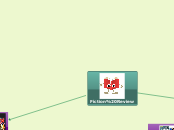jonka Leslie Evans 7 vuotta sitten
1120
Literary Devices Review

jonka Leslie Evans 7 vuotta sitten
1120

Lisää tämän kaltaisia
Genre- a type of art, music, or literature characterized by a specific form
The Outsiders
apocalypse fiction
The Walking Dead
dystopian fiction
Maze Runner
The Hunger Games
1984
Consonance- Repeated consonant sounds, but not at the beginning of the words.
onomatopoeia: When a word sounds like the word it's describing
pow
Buzz
Pop
alliteration: repeated letter sounds at the beginning of words
"Peter Piper picked..."
"Sally sells seashells by the seashore
Figurative Language: Language that is not meant to be taken literally.
Idiom- a figure of speech commonly used by people
"It's raining cats and dogs."
"You're on fire!"
hyperbole: exaggeration
I told you a million times.
Personification: when animals, things, or inanimate objects have human characteristics
"The trees were dancing and waving hello."
"The sun woke me up with a smile."
Simile- comparing 2 things using "like" or "as"
"Love is like a battlefield."
"Mindomo is as fun as video games"
metaphor: Comparing 2 things WITHOUT using "like" or "as"
"Love is a battlefield."
"I am an ice cube."
Conflict: the problem or issue the main character needs to solve
External Conflict: A struggle between the main character and outside forces
Man Vs. Technology
Man Vs. Society
Man Vs. Nature
Man vs Man
Internal Conflict: issues that characters struggle with privately; a psychological struggle within the mind of a character
Man Vs. Self
Theme- The moral of a story; a life lesson within a story; a message about life the author is trying to convey
*Note: Theme is always expressed in a complete sentence- not a single word. If you think the theme of a story is about "friendship", you are thinking about a subject instead of a theme. Ask yourself: What is the author trying to SAY about friendship?
Setting: Where and when a story takes place. Setting also includes cultural environment
Antagonist- the main opposing force.
Antagonists are often thought of as the "bad guys", but sometimes the antagonist is just DIFFERENT from the protagonist.
Antagonists are not always human characters. They can be nature, technology, etc- basically anything can be an opposing force.
Protagonist- The main character, usually the hero of the story
Foreshadowing- When the author of a story gives hints about what's going to happen in the future
Flashback- When the author of a story jumps back in time to have the character relive an important event or experience
Plot Structure- sequence of events organized into exposition, rising action, climax, falling action, and resolution
Resolution
Resolution: The part of a story in which the main problems are solved
Falling Action
Falling action: The part of a story that happens after the most exciting point, but before the problems are solved
Climax
Climax: the most exciting part of a story when the tension is at the highest point
Rising Action
Rising Action: The events building up to the climax which build interest, tension, or suspense
Exposition
Exposition- Beginning of the story when the reader learns about background information, characters, setting, and environment